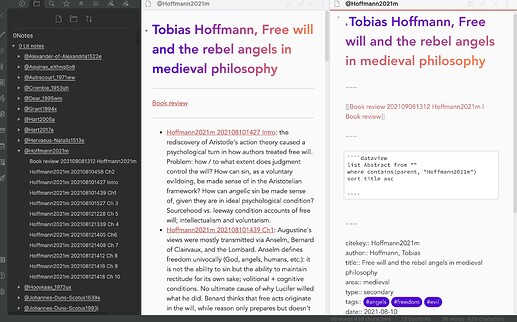I would recommend not creating any folders until you have a lot of notes. If you do, you will likely guess wrong and end up having to redo everything (that’s what I did a few times). When you have several hundred notes (or more), you could then do a type of affinity diagram of your notes and let the folders emerge from your notes. This way, you don’t impose an artificial order but find an organic approach that is unique to your thoughts.
Contrary to what many recommend, I use a lot (dozens) of tags. You can use tags like a folder structure. However, tags are more versatile than folders because you can have the same note tagged in multiple ways. Additionally, you can add and remove tags easily without needing to change a folder structure. You can search for multiple tags to narrow down your thoughts so a specific area of thinking as well. For example, I can bring up my tags for #psychology/topic/anxiety and psychology/therapy/intervention and quickly see my thoughts about how to help a client with anxiety. All my thoughts on the concept of anxiety will not show because of the added tag of intervention. I can’t do that with folders of a standard search (that I know of). This is similar to the tagging in Zotero (very useful).
Adding tags for type (e.g., book, article, idea, etc.), stage (e.g., to-do, doing, done), or anything else can be added and changed very easily.
At first, such a huge tagging system is cumbersome, but over time, it gets easier to use. If you then want to replicate your main tag headings (e.g., psychology) and make a folder system like the Johnny Decimal system, it’s easy to do.
As for the symbols, you will get used to them. Moreover, they focus you on writing since there isn’t much you can do other than make headings and a bullet lists.
Finally, the Zettelkasten approach can be interpreted in many ways, it seems. I break it down into two piles: your words or someone else’s words. Reference notes are someone else’s words. Literature and Permanent notes are your words (with a few quotes tossed in at times). Next, two more divisions: your thoughts and someone else’s thoughts. Literature notes are someone else’s thoughts in your words. Permanent notes are your thoughts in your words (but almost certainly derived from Literature notes). Finally, Fleeting notes are short notes like you would write on a napkin or scrap paper so you don’t forget to revisit that thought later when you have more time or energy. For me, these might be something like “In the book Couple’s Couneling on page 178, it says emotions are hard to control when upset. Research the neuroscience on this idea.” I then tag it as a fleeting note, neuroscience, emotions, and to-do. Now, even if I forget about that thought for a month, it’s sitting there awaiting my return.
Project notes are long-form writings (articles, book chapters) that, for me, are just included Permanent notes. Permanent notes, for me, are focused paragraphs, which, by definition, are one idea with supporting information, or single arguments.
Literature notes, for me, are bullet lists of paraphrasing Reference notes. I like to put these in the same note as the Reference note so I know where they came from. Others seem to prefer making separate notes that link back to the origin.
Finally, Published notes are Project notes that I have shared publicly (usually) and sometimes privately (like this note). In the Published note, include a section that tells you where and when you published the note. Each time you re-use it, you can update that section so you know all the places where that note has been shared. If these are made as links or tags, you can see all your publications to that source. So, if you write a resume and then share it, each time you do so, just update it so you know who you shared it with and when. If you have a tag such as #Type/Published the tag pane will show you how many you have published. If you publish to a place like Medium, you could have a tag such as #Type/Published/Medium and can quickly see how many articles you have published on Medium. If you click on that tag, you can now see a list of all the articles you published there. The same goes for emails or forum replies. You could tag this as #Type/Published/Forum/Obsidian and easily see all your Obsidian forum posts.
I hope this is a little helpful.


